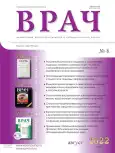Функциональная активность микробиоты кишечника, жировой ткани и инкретинов при ожирении в детском возрасте
- Авторы: Самойлова Ю.Г.1, Саган Е.В.1, Олейник О.А.1, Кудлай Д.А.2,3, Матвеева М.В.1, Подчиненова Д.В.1, Коваренко М.А.1, Ворожцова И.Н.1, Павленко О.А.1
-
Учреждения:
- Сибирский государственный медицинский университет Минздрава России
- Первый МГМУ им. И.М. Сеченова Минздрава России (Сеченовский Университет)
- Государственный научный центр «Институт иммунологии» Федерального медико-биологического агентства России
- Выпуск: Том 33, № 8 (2022)
- Страницы: 41-45
- Раздел: Из практики
- URL: https://journals.eco-vector.com/0236-3054/article/view/114668
- DOI: https://doi.org/10.29296/25877305-2022-08-08
- ID: 114668
Цитировать
Полный текст
Аннотация
Ожирение - многофакторное заболевание. В настоящее время активно изучается влияние микробиоты кишечника на метаболическое здоровье человека. В литературе описываются многие механизмы данного воздействия, основным является синтез короткоцепочечных жирных кислот, которые являются лигандами рецепторов GPR41 и GPR43 для синтеза многих гормонов (инсулин, глюкагон, лептин, ирисин). Цель исследования - изучить метаболическую активность микробиоты толстого кишечника и ее взаимосвязь с секрецией гормонов жировой ткани, инкретинов у детей с ожирением и избыточной массой тела. В исследовании участвовали 74 ребенка и подростка с избыточной массой тела и ожирением, а также 44 здоровых ребенка, сопоставимых по возрасту и полу. В ходе исследования получены данные о снижении гормональной активности (ирисин, резистин, глюкагон, GLP-1 и GLP-2) на фоне снижения метаболической активности микробиоты, при этом у детей с избыточной массой тела и ожирением отмечалась положительная корреляционная связь с основными гормонами и инкретинами. Снижение метаболической функции микробиоты (в большей степени синтеза масляной кислоты) возможно связано со снижением в рационе детей с ожирением и избыточной массой тела неперевариваемых пищевых волокон, а также косвенным образом свидетельствует о снижении количества и (или) активности бутират-продуцирующих бактерий. Механизмы и направления связей между функциональной активностью микробиоты кишечника, гастроинтестинальной системы и некоторыми адипокинами требуют дальнейшего изучения и понимания.
Ключевые слова
Полный текст
Об авторах
Ю. Г. Самойлова
Сибирский государственный медицинский университет Минздрава России
Email: oleynikoa@mail.ru
доктор медицинских наук, профессор
Е. В. Саган
Сибирский государственный медицинский университет Минздрава России
Email: oleynikoa@mail.ru
О. А. Олейник
Сибирский государственный медицинский университет Минздрава России
Автор, ответственный за переписку.
Email: oleynikoa@mail.ru
кандидат медицинских наук, доцент
Д. А. Кудлай
Первый МГМУ им. И.М. Сеченова Минздрава России (Сеченовский Университет); Государственный научный центр «Институт иммунологии» Федерального медико-биологического агентства России
Email: oleynikoa@mail.ru
член-корреспондент РАН, доктор медицинских наук
М. В. Матвеева
Сибирский государственный медицинский университет Минздрава России
Email: oleynikoa@mail.ru
доктор медицинских наук
Д. В. Подчиненова
Сибирский государственный медицинский университет Минздрава России
Email: oleynikoa@mail.ru
кандидат медицинских наук, доцент
М. А. Коваренко
Сибирский государственный медицинский университет Минздрава России
Email: oleynikoa@mail.ru
кандидат медицинских наук
И. Н. Ворожцова
Сибирский государственный медицинский университет Минздрава России
Email: oleynikoa@mail.ru
доктор медицинских наук, профессор
О. А. Павленко
Сибирский государственный медицинский университет Минздрава России
Email: oleynikoa@mail.ru
доктор медицинских наук, профессор
Список литературы
- Петеркова В.А., Безлепкина О.Б., Болотова Н.В. и др. Клинические рекомендации «Ожирение у детей». Проблемы эндокринологии. 2021; 67 (5): 67-83. doi: 10.14341/probl12802
- Васюкова О.В. Ожирение у детей и подростков: критерии диагноза. Ожирение и метаболизм. 2019; 16 (1): 70-3. doi: 10.14341/omet10170
- Савчук Д.В., Шин В.Ф., Теплякова Е.Д. и др. Кишечная микробиота и ее взаимосвязь с ожирением у детей. Вопросы детской диетологии. 2019; 17 (5): 54-61. doi: 10.20953/1727-5784-2019-5-54-61
- Гурова М.М., Новикова В.П., Хавкин А.И. Состояние кишечной микробиоты и клинико-метаболические особенности у детей с избыточной массой тела и ожирением. Доказательная гастроэнтерология. 2018; 7 (3): 4-10. doi: 10.17116/dokgastro201870314
- Корниенко Е.А., Нетребенко О.К. Ожирение и кишечная микробиота: современная концепция взаимосвязи. Педиатрия. Журнал им. Г.Н. Сперанского. 2012; 91 (2): 110-22.
- Иконников Н.С., Ардатская М.Д., Бабин В.Н. и др. Патент на изобретение РФ №2145511 «Способ разделения смеси жирных кислот фракции С2-С7 методом газожидкостной хроматографии» от 09.04.1999. URL: http://www1.fips.ru/fips_servl/fips_servlet?DB=RUPAT&rn=8868&DocNumber=2145511&TypeFile=html
- Захарова И.Н., Бережная И.В., Скоробогатова Е.В. и др. Микробиота кишечника у детей с ожирением. Роль пробиотиков. Медицинский совет. 2020; 10: 134-42. doi: 10.21518/2079-701X-2020-10-134-142
- Dahiya D.K., Renuka Puniya M., Shandilya U.K. et al. Gut Microbiota Modulation and Its Relationship with Obesity Using Prebiotic Fibers and Probiotics: A Review. Front Microbiol. 2017; 8: 563. doi: 10.3389/fmicb.2017.00563
- Rahat-Rozenbloom S., Fernandes J., Gloor G.B. et al. Evidence for greater production of colonic short-chain fatty acids in overweight than lean humans. Int J. Obes (Lond). 2014; 38 (12): 1525-31. doi: 10.1038/ijo.2014.46
- Kasubuchi M., Hasegawa S., Hiramatsu T. et al. Dietary gut microbial metabolites, short-chain fatty acids, and host metabolic regulation. Nutrients. 2015; 7 (4): 2839-49. doi: 10.3390/nu7042839
- Fredborg M., Theil P.K., Jensen B.B. et al. G. protein-coupled receptor120 (GPR120) transcription in intestinal epithelial cells is significantly affected by bacteria belonging to the Bacteroides, Proteobacteria, and Firmicutes phyla. J. Anim Sci. 2012; 90 (Suppl 4): 10-2. doi: 10.2527/jas.53792
- Karlsson F.H., Tremaroli V., Nookaew I. e al. Gut metagenome in European women with normal, impaired and diabetic glucose control. Nature. 2013; 498 (7452): 99-103. doi: 10.1038/nature12198
- Bomhof M.R., Saha D.C., Reid D.T. et al. Combined effects of oligofructose and Bifidobacterium animalis on gut microbiota and glycemia in obese rats. Obesity (Silver Spring). 2014; 22 (3): 763-71. doi: 10.1002/oby.20632
- De La Serre C.B., de Lartigue G., Raybould H.E. Chronic exposure to low dose bacterial lipopolysaccharide inhibits leptin signaling in vagal afferent neurons. Physiol Behav. 2015; 139: 188-94. doi: 10.1016/j.physbeh.2014.10.032
- Schroeder B.O., Birchenough G.M.H., Stahlman M. et al. Bifidobacteria or Fiber Protects against Diet-Induced Microbiota-Mediated Colonic Mucus Deterioration. Cell Host Microbe. 2018; 23 (1): 27-40.e7. doi: 10.1016/j.chom.2017.11.004
- Самойлова Ю.Г., Олейник О.А., Саган Е.В. и др. Микробиота и метаболическое программирование ожирения у детей. Педиатрия. Журнал им. Г.Н. Сперанского. 2020; 99 (1): 209-16. doi: 10.24110/0031-403x-2020-99-1-209-216
- Bauer P.V., Hamr S.C., Duca F.A. Regulation of energy balance by a gut-brain axis and involvement of the gut microbiota. Cell Mol Life Sci. 2016; 73 (4): 737-55. doi: 10.1007/s00018-015-2083-z
- Ардатская М.Д. Клиническое значение короткоцепочечных жирных кислот при патологии желудочно-кишечного тракта, Дисс. д-ра мед. наук. М., 2003; 299 с.
Дополнительные файлы








